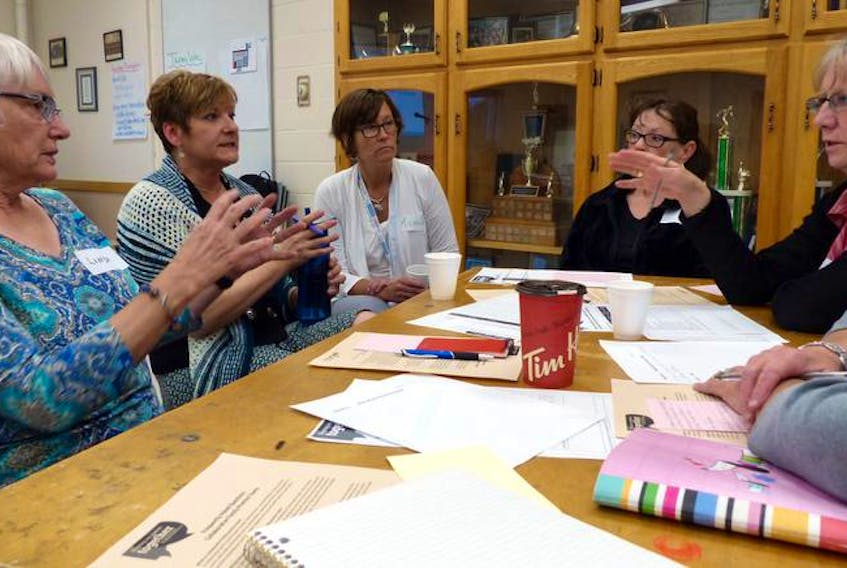Collaborative family practice teams are an effective method of dispensing and receiving health care. But Nova Scotians without access to primary care providers are shut out from the benefits of such a system.
That was the consensus among those who turned out for a June 14 community conversation on collaborative family practice teams at the Shelburne Community Centre.
The Nova Scotia Health Authority (NSHA) is holding these public sessions all around the province. Shelburne was the 19th such community conversation. NSHA plans to hold these sessions in every county in the province.
A collaborative family practice team includes family doctors, nurse practitioners, family practice nurses and other health professionals such as social workers and dietitians. The makeup of each collaborative family practice team varies from one community to the next, depending on the needs of the community.
“It is a team of health providers, all with different expertise in primary care, that come together so that the population of people that they’re there to serve gets the best care from the best person in the most appropriate period of time,” explained Dr. Crystal Todd, NSHA’s chief of family practice for the western zone.
“As opposed to one person trying to provide care for a whole scope of things, you’ve got a team of people that can all lend their expertise at different times and they all work together for the best care for the community.”
Because primary care personnel are being trained to work in a team environment, Todd added, collaborative family practices are generally more appealing than individual practices, though some family doctors may still opt to work in an individual practice.
Another advantage to a collaborative family practice team is that all personnel within that team share a patient’s medical chart, thus enhancing communication for patients and their providers as they visit different personnel on the team.
“Comprehensive care, continual care, is so much better,” Todd said.
Shelburne already has a collaborative family practice team. That team is currently working out of temporary offices in Roseway Hospital and will be moving into a new clinic in the fall.
Todd acknowledged that Nova Scotia has a shortage of primary care providers, which means that not all Nova Scotians will have immediate access to primary health care within their own community.
And even in communities with a collaborative family practice team, not all members of that community will have access to the services of that team.
However, Todd explained, having a collaborative family practice team may enable that team to expand its patient roster.
“As you grow, as you become more efficient and comfortable as a team, it allows you to increase your capacity. If I was a solo physician, working by myself, I would only be able to maintain a practice of X amount of patients. But if I’m part of a team, including a nurse practitioner and family practice nurse, who are offloading some of the stuff that it takes up my time to do, then as a team we can have a bigger roster.”
Todd noted that collaborative family practice teams are also appealing in the recruitment and retention of primary care personnel.
Shelburne’s new collaborative health centre being built next to Roseway Hospital is scheduled for completion in the fall. The new centre will house Shelburne’s family practice team. It will not be a walk-in clinic. People still must be a patient of the family practice in order to be seen by one of the providers.
However, the Shelburne family practice team is accepting pregnant women or children six years old or younger, who are currently without a primary care provider, as new patients. People in either category should call the Shelburne family practice team at 902-875-2321.
In Shelburne County (which includes Shelburne, Barrington and Lockeport), 461 people — 3.2 per cent of the area’s population — were registered on the province’s Need a Family Practice list as of June 1.
People at the Shelburne community conversation expressed doubt that that number presents an accurate picture of Shelburne County residents who are without a primary care provider. They worry that many more have not yet registered for the list, and so NSHA is not getting a true picture of the need for family physicians and nurse practitioners.
“How can you assess the health care needs of the community if they don’t already belong to the system, don’t already have a family doctor?” asked Shelburne Mayor Karen Mattatall.
Penny Smith, warden with the Municipality of the District of Shelburne, voiced a similar concern. “How do you access primary health care when you don’t have a family doctor?”
For most people, that means visiting an emergency department like that at Roseway Hospital, which doubles as an outpatient clinic.
NSHA personnel at the Shelburne session stressed the importance of registering for the Need a Family Practice list, so that NSHA can accurately determine the need for primary care providers in a given area. Getting on the Need a Family Practice list also puts registrants in line for the next available primary care provider in their area.
To register for the Need a Family Practice list, call 811 or visit needafamilypractice.nshealth.ca.
Anyone who wasn’t able to attend a public session can still provide input online by visiting talkaboutfamilypracticeteams.ca. Followup reports on each session are being posted on the website, along with a schedule of dates and locations for future community conversations.








